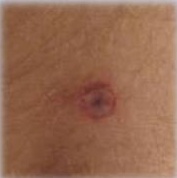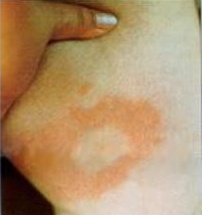LYME DISEASE IN OUR HUNT COUNTRY
an essay by John Fuhring
Introduction
Just recently I was asked my opinion regarding our chances
of contracting Lyme disease here in our hunt country. Since I had
not read or heard of any reports of the disease being endemic to our
region and because in over 30 years of pulling ticks off myself (I am a
certified "tick magnet"), I offered the opinion that our risk was "slim
to none." Of course, that was an off-the-cuff opinion from a person
that is neither a medical doctor or educated in epidemiology
(although I have a smattering of biochemistry and microbiology).
Having expressed my opinion without anything to back it, I
thought I'd at least do a little research so that I could undo any harm
a wrong opinion might have cause. So far, the research into the tick
situation and the chances of any of us contracting Lyme disease
supports my original opinion and so I would like to present that
information to you for your own evaluation.I like to tell the story of how a tick nearly killed me. I have a professional grade microscope and I really like to see bacteria and things for myself. Once after a hunt, I picked a tick off myself and decided to really get to know these nasty little creatures close up. I put the tick in a small sample bottle of pure ethyl alcohol (alcohol I use for Gram Staining) and I was sure that would kill it. When I was sure the tiny monster was dead, I put it under my microscope and illuminated it from the top and sides so that I could see every part of it. I had charts of the anatomy of ticks, so I was fascinated to be seeing and identifying all these parts right where they should be and my mind was lost to the world. I was completely absorbed in seeing this creature hugely enlarged in my eyepieces and while so engaged, I forgot just how small the thing really was because it looked so huge in my microscope.
As I mentioned, I thought the creature just had to be dead, but when it started to move and it extend its front set of legs in a direction that looked exactly as if it were trying to grab me, my panic was complete. Without thinking and very scared, my gut reaction was to get away from a monster that was coming after me and trying to grab me. I leaned way back in my chair and lost my balance and fell over backwards. I could have broken my neck or if hitting on a hard floor, a table or a desk behind me, I could have easily fractured my skull. Fortunately there was nothing directly behind me and so I landed on a deep carpet and the carpet took up the shock of the back of my head hitting the floor. And that, dear friends, is how a tick nearly killed me.
Where are the Lyme Disease "Hot Spots" and is our area one of them?
I came across a map showing the areas of confirmed cases of Lyme
Disease and as you can see, our part of the United States shows nothing
for Santa Barbara county or any of the places to the east where we
might hunt. This alone is a strong reason to believe that our
chances of
contracting Lyme Disease is extremely small to the point that we might
ride anywhere in our hunt country with confidence..
Of
course, if you live on the East Coast or the Northern Midwest and spend
a lot of time outdoors hunting and camping, your chances of contracting
Lyme Disease are much greater.
Lyme Disease is caused by a tiny corkscrew shaped bacteria called a "spirochete" that is rather difficult to see in an ordinary microscope and so it wasn't discovered until rather lately. For a long time, many people didn't believe there was an actual disease because an infectious agent was missing. Now it is recognized that the disease actually exists and is rather common in the North East and Northern Midwest, but rare elsewhere.
Lyme Disease is transmitted to humans by ticks and by accident because humans are not the natural host of ticks. Of course, ticks will take advantage of any creature, including lizards, that have blood to suck. Ticks are actually much more closely related to spiders than to insects and believe it or not, spiders and insects are not at all related. The last time insects and ticks shared a common ancestor was probably around 600 million years ago. In fact, we are much more closely related to fish than insects are to ticks.
Instead of having mouth parts, as do insects, these creatures have modified pincers (called chelicera) that have on their ends very sharp blade-like structures. They use those tiny blades to painlessly cut through the skin of their victim where they project a barbed shaped structure (called a hypostome) into the wound they have created and use it to suck up blood and other nutritious liquids.

Redness associated with a
deeply buried tick. The
redness is not a sign of
Lyme Disease.
Normally a tick is removed
long before this.
What causes Lyme Disease, how is it spread,
what are the symptoms and signs and finally, what are the treatments?
Lyme Disease is caused by a tiny corkscrew shaped bacteria called a "spirochete" that is rather difficult to see in an ordinary microscope and so it wasn't discovered until rather lately. For a long time, many people didn't believe there was an actual disease because an infectious agent was missing. Now it is recognized that the disease actually exists and is rather common in the North East and Northern Midwest, but rare elsewhere.
Lyme Disease is transmitted to humans by ticks and by accident because humans are not the natural host of ticks. Of course, ticks will take advantage of any creature, including lizards, that have blood to suck. Ticks are actually much more closely related to spiders than to insects and believe it or not, spiders and insects are not at all related. The last time insects and ticks shared a common ancestor was probably around 600 million years ago. In fact, we are much more closely related to fish than insects are to ticks.
Instead of having mouth parts, as do insects, these creatures have modified pincers (called chelicera) that have on their ends very sharp blade-like structures. They use those tiny blades to painlessly cut through the skin of their victim where they project a barbed shaped structure (called a hypostome) into the wound they have created and use it to suck up blood and other nutritious liquids.

Redness associated with a
deeply buried tick. The
redness is not a sign of
Lyme Disease.
Normally a tick is removed
long before this.
Backpackers and wilderness travelers, who may be out for days or even weeks at
a time, might have ticks that have burrowed deeply into their skin, but
it is unlikely that any of us will have ticks that will get this far
in. In any case, a tick may be removed by carefully grasping it
and pulling it out. Do not try to "burn" it as you will damage
your skin and end up with a dead tick inside of you. Try not to
squeeze too hard when pulling one out. There is another thing you should know, it takes between 24 and 48
hours for the Lime bacteria to pass from the tick into a human. Normal
hygiene removes ticks long before this.
As ugly and horrifying it is to discover a tick on you and especially IN you, there is only one species of tick, the Black Legged Tick, that carries Lyme Disease here in California, and here it is a pretty rare species, unlike the cattle ticks we run across all the time.
In the picture above, notice that there is redness of the skin immediately surrounding the tick. This is a normal immune reaction to any parasite entering the skin and not necessarily a sign of Lyme Disease. After removal of the tick, the wound should heal normally as shown in the pictures below.


As ugly and horrifying it is to discover a tick on you and especially IN you, there is only one species of tick, the Black Legged Tick, that carries Lyme Disease here in California, and here it is a pretty rare species, unlike the cattle ticks we run across all the time.
In the picture above, notice that there is redness of the skin immediately surrounding the tick. This is a normal immune reaction to any parasite entering the skin and not necessarily a sign of Lyme Disease. After removal of the tick, the wound should heal normally as shown in the pictures below.


Normal redness from a healing tick bite. These pictures are
not indicative of Lyme Disease.
However, in about 60% of Lyme infections, a larger
and more serious redding of the skin develops and that is a pretty sure
sign that you have the disease, but remember that this rash only occurs
in 60% of infections. In other words, you might still have Lyme Disease even though you haven't developed the rash.

Redness indicating Lyme Disease
Early symptoms of Lyme infections besides the rash include muscle ache, headache, fever and just feeling bad like you have the flu. At this stage the disease is easily treated with common oral antibiotics like doxycycline, but it may take a while to rid your body of the disease.
Again I will remind you that I am not an expert or hold any license in this field. My hope is that this essay will cause you to explore this topic using information only from scientifically trained experts and avoid taking advice from scaremongers and quacks.
Best Regards,
John Fuhring

Redness indicating Lyme Disease
Early symptoms of Lyme infections besides the rash include muscle ache, headache, fever and just feeling bad like you have the flu. At this stage the disease is easily treated with common oral antibiotics like doxycycline, but it may take a while to rid your body of the disease.
Conclusions:
I give this detail
only for informational purposes and not to exaggerate the likelihood of
contracting Lyme Disease in our region. Again, the likelihood is
vanishingly small and in my lifetime of pulling off ticks, I've never
contracted the disease nor have I met anybody who
had a medically confirmed case of it although I have met people who
were never bitten by a tick in their life who claimed to have it.
I will say again, it is my opinion that we may
ride in our hunt country with confidence that Lyme Disease is a tiny
risk we can certainly live with.Again I will remind you that I am not an expert or hold any license in this field. My hope is that this essay will cause you to explore this topic using information only from scientifically trained experts and avoid taking advice from scaremongers and quacks.
Best Regards,
John Fuhring